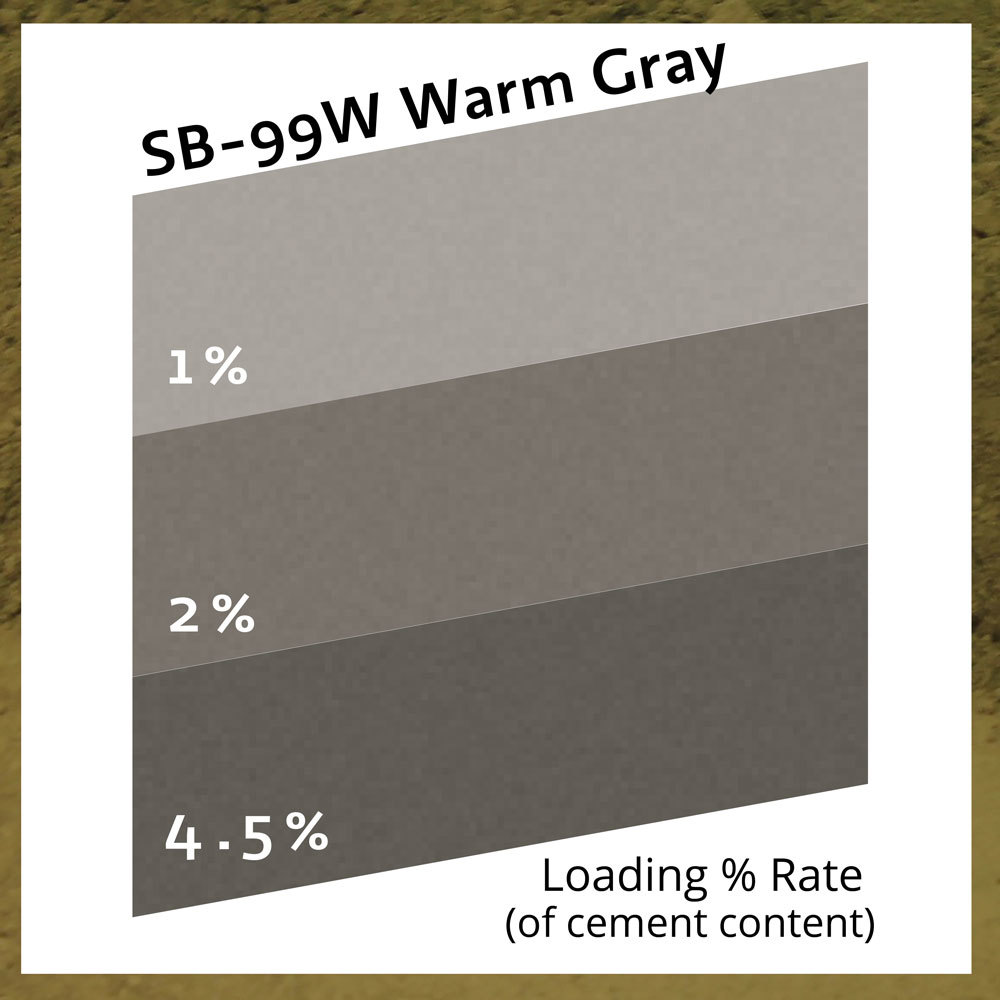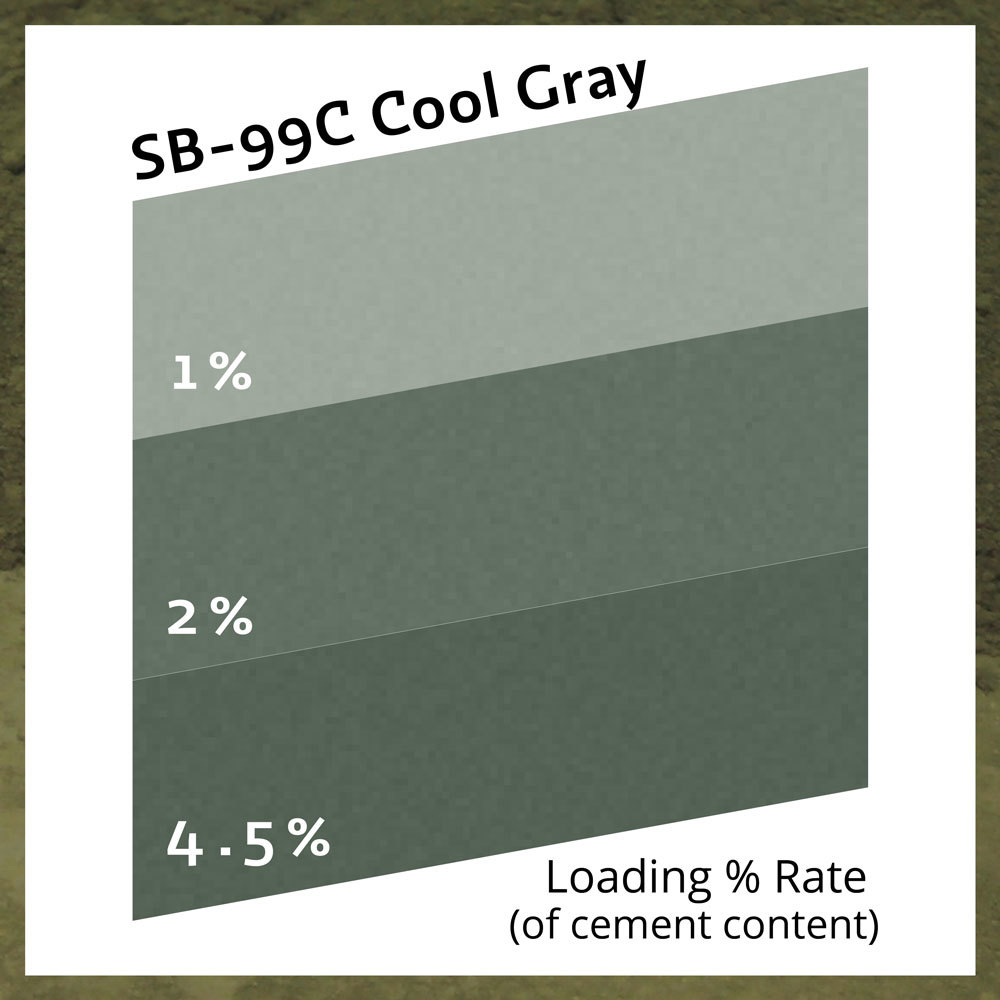Concrete made using only gray Portland cement gets its color because of the cement. In addition, gray Portland is used as a color modifier, changing bright and sometimes harsh colors into muted, subtle earth tones. Khaki, sage green and cinnamon are some good examples of colors that are made by blending gray cement with white cement and pigments.
Gray Portland cement is ubiquitous, cheap and readily available. Used properly it can make very strong and durable concrete. If color wasn’t an issue we’d only use gray cement, but for us, the color consistency of our concrete is vitally important. This is where gray Portland cement lets us down.
What Makes Gray Cement Gray?
According to the Portland Cement Association, “cement is manufactured through a closely controlled chemical combination of calcium, silicon, aluminum, iron and other ingredients.”
Portland cement is manufactured by crushing, milling and proportioning the following materials:
-
- Lime or calcium oxide, CaO: from limestone, chalk, shells, shale or calcareous rock
- Silica, SiO2: from sand, old bottles, clay or argillaceous rock
- Alumina, Al2O3: from bauxite, recycled aluminum, clay
- Iron, Fe2O3: from from clay, iron ore, scrap iron and fly ash
- Gypsum, CaSO4.2H20: found together with limestone
For economic and practical reasons, cement plants draw their raw materials from local sources. This means that the cement made at each plant starts with various blends of different raw materials. As long as the end product meets industry standards for chemical composition and strength development, the color of the cement is considered unimportant. The “close control” referred to above disregards color.
The characteristic greenish-gray to brownish-gray color of ordinary Portland cement derives from a number of transition elements in its chemical composition. These are, in descending order of coloring effect: chromium, manganese, iron, copper, vanadium, nickel and titanium.
Portland cement is usually made from cheap, quarried raw materials, and these usually contain substantial amounts of chromium, manganese and iron. The quantities of these transition elements vary depending upon the raw ingredients, and since these rarely have any significant effect on strength, the amount of variation can be large. However, they do have an effect on color.
All this means is that the color of gray cement can and often does vary, both brand to brand and even batch to batch. Gray cement can be light, dark, brownish, greenish or some other shade, hue and variation of gray.
What Makes White Cement White?
White Portland cement is a true Portland cement that differs from gray cement chiefly in color. It is made to conform to the specifications of ASTM C 150. White Portland cement is made of selected raw materials containing negligible amounts of iron and magnesium oxides—the substances that give cement its gray color.
Making Gray from White
Trying to create the authentic color of gray cement using white cement can be difficult at best. Simply adding black pigment to white cement creates lovely shades of gray that are cool in tone (bluish), but natural Portland cement gray is a warm, complex gray that has greenish brown undertones, and those undertones make it difficult to reproduce. Until now.
For the first time it’s possible not only to create an absolutely convincing natural gray cement color using only white cement and two pigments, but also to create the subtle shade of natural gray cement color that you want. By blending the Buddy Rhodes Warm Gray and Cool Gray pigments in various ratios, it is possible to shift the gray to be browner, or greener or darker or lighter. Either match your favorite gray Portland cement color or create one you wish you had.

Buddy Rhodes Warm Gray pigment

Buddy Rhodes Cool Gray pigment
And since you can control the color’s hue and tone, making earth tone concrete colors that used to depend upon gray cement now becomes easier and more consistent. If in the past you made sage green using chromium oxide green pigment and a blend of gray and white cement, variations in the gray cement would cause unpredictable variations in the resulting concrete color. Now, by using only white cement, the same sage green color can be made with greater precision, giving you more confidence in your colors.
All of my basic color formulas to use white cement. All of the subtle colors such as Natural Gray, Sage Green and Bisque are now reliable and consistent. My Mix Calculators come with 13 starter colors that are the most popular earth tones, and the color formulas are also available as a standalone calculator.
With this fine-tuned control comes a need to understand the precision required of your scale. See this article about how to select scales with the precision required by high quality custom concrete.
Benefits of Eliminating Gray Cement
Making color samples is time consuming, and using an ingredient as unpredictable and variable as gray cement means colors made with it have an expiration date. Once your gray cement changes, any color sample made with the “old” cement will no longer match concrete made with the “new” cement.
When you’re at the pro level and have dozens or even hundreds of samples and multiple showroom displays, a color change can be disastrous for your business. This happened to me years ago, but until now there was no way to avoid the vagaries of gray cement. Color consistency is very important, so eliminating the unpredictable ingredient means you don’t need to make new color samples on an ongoing basis.
There is also no longer a need to stockpile both gray and white cement, since the only color cement you need is white. This simplifies your inventory, allowing you to purchase in bulk, and that helps to control cost.
White cement is more expensive than gray cement – for example it might be $24 per bag versus $8 per bag. However, a single bag of cement can make about 34 square feet of GFRC, meaning that the additional $16 adds less than $0.50 per square foot to your material costs. One other approach to consider is using quality-controlled bagged mixes based on white cement, again buying in bulk to save on material costs. Material costs are low in comparison with labor costs, and buying in bulk (and saving on shipping) is the biggest way you can save on material costs, not skimping on the unit cost of every material.

